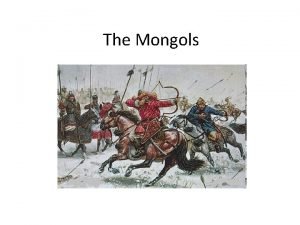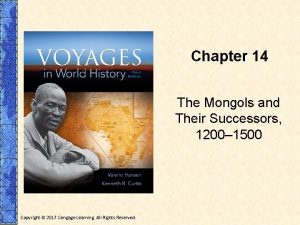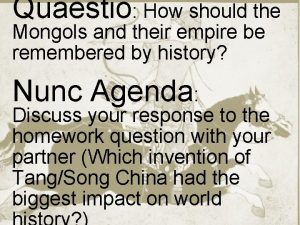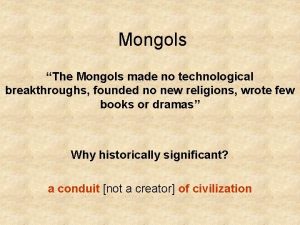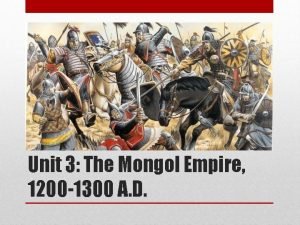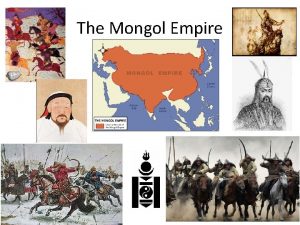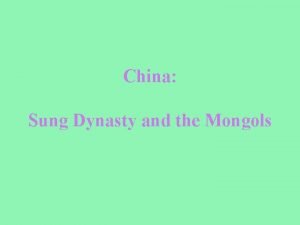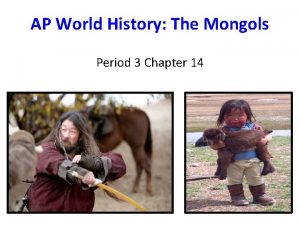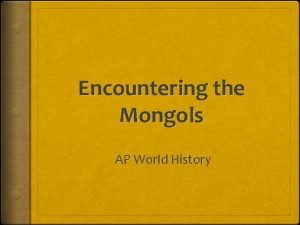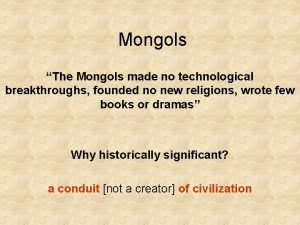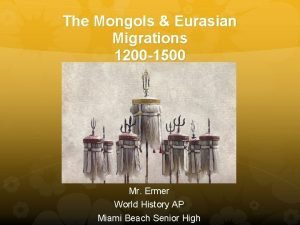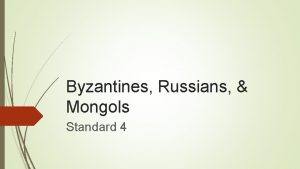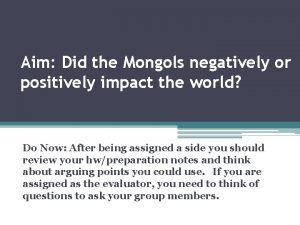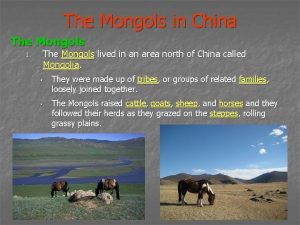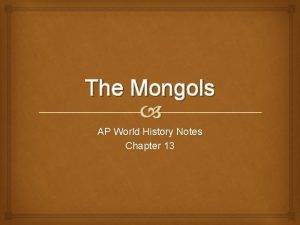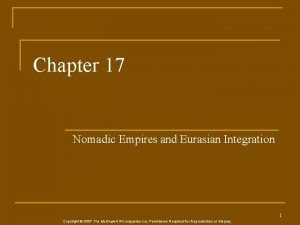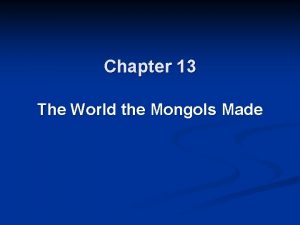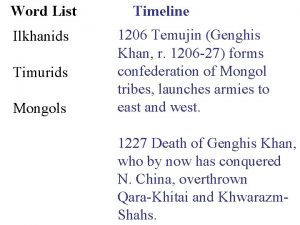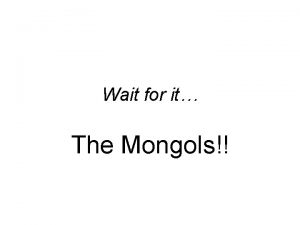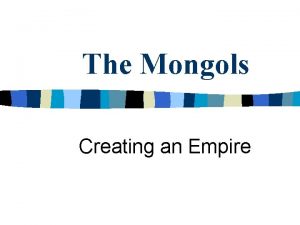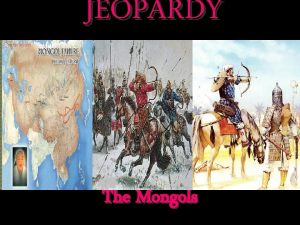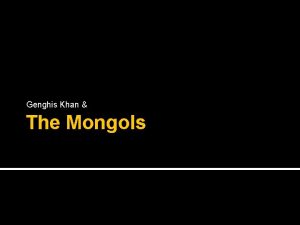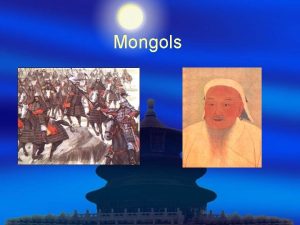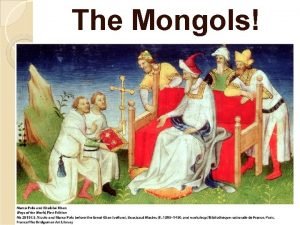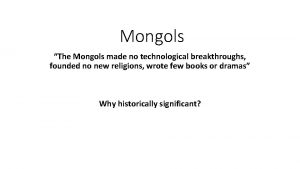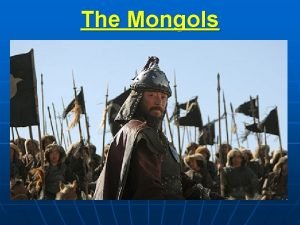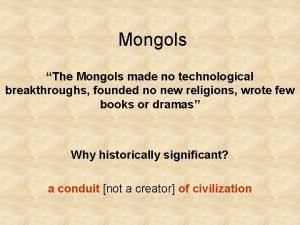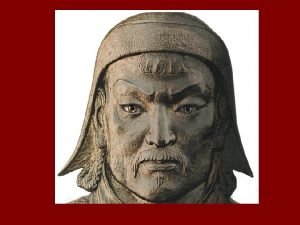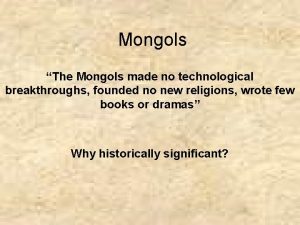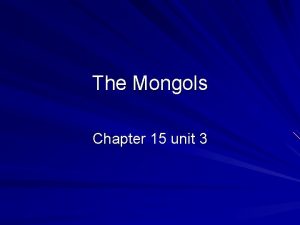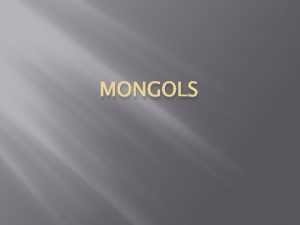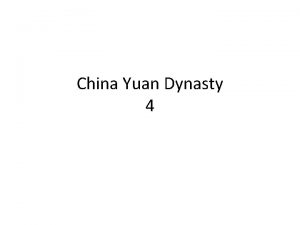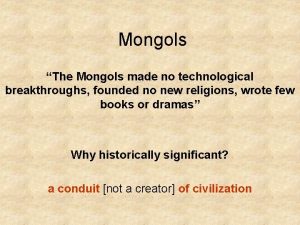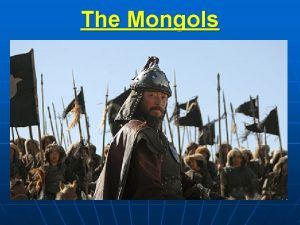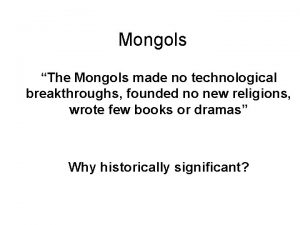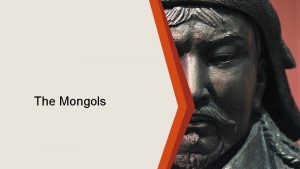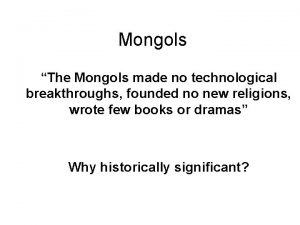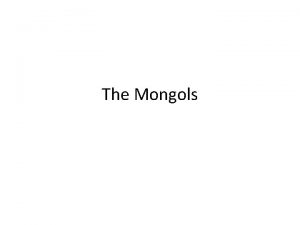I The Rise of the Mongols A From




































- Slides: 36

I. The Rise of the Mongols

A. From Tent to Palace… “Man’s highest joy is victory: to conqueror one’s enemies, to pursue them, to deprive them of their possessions, to make their beloved weep, and to embrace their wives and daughters. ” -- nomadic horse people -- northern Chinese grasslands (Mongolia) -- raised horses, tended sheep -- lived in felt tents called yurts (ger) -- could NOT intermarry between tribes & clans

Mongolian Steppe

Mongol “Yurt”

1. 5 million Mongols

B. Organization 1. families-->clans-->tribes--> -- tribes gathered during annual migration 2. chiefs elected (based on nobility, military ability, leadership) -- Khan (“ruler”) title given to chief 3. religion: Shamanism --nature deities

C. Temüjin: Ghengis Khan 1. 1167 -1227, son of tribal chief 2. father poisoned…fled as youth 3. by 40 had unified all Mongol tribes 4. empire ruled by sons & grandsons after death Genghis Khan

z Genghis Khan’s Tax Laws: l l If you do not pay homage, we will take your prosperity. If you do not have prosperity, we will take your children. If you do not have children, we will take your wife. If you do not have a wife, we will take your head. z Used cruelty as a weapon

The Khan Family Genghis Khan Jochi Batu Jagadai Tolui Ögödei Güyük Möngke Khubilai Hülegü

D. Conquest 1. intelligence gathering: foreign experts/advisors (in Persian & Chinese) 2. every man carried own supplies & had 2 horses - survived mostly off horse milk & blood 3. vassal system: commanders running army & gov’t l l brought Chinese engineers conquered most of Asia, Middle East, Russia

32 million square km’s…

E. Mongol Army Tactics 1. all males 15 -70 served in army as cavalry 2. organized army in “Myriads” (10, 000’s) 3. no one in army was paid, though shared in war booty 4. tactics: --Chinese siege technology & catapults --horsemanship, compound bow --elaborate signals (flags, hands) --retreat, turn, flank, destroy --fear

Mongol Warriors



F. Results of Expansion 1. increased trade & revival of Silk Road 2. facilitated movement of goods, merchants, & diplomats 3. unified law code (Yasa) 4. travelers encountered new languages, laws & customs 5. spread of disease & bubonic plague

Thesis Statement Writing Exercise: § How did the Mongols, with a total population of less than 1. 5 million, conqueror such a large area and hold onto it for over a century?

II. Mongol Eurasia

A. The Conquest of China 1. Genghis Khan wanted the riches of China 2. 1227 conquered Beijing, but died same year 3. successors took all of China

B. Divisions at Genghis Khan’s Death Four Khanates: 1. “Golden Hoarde” (Russia) 2. Il-Khanate (Persia) 3. Jagadai Khanate 4. Yuan Dynasty

C. Il-Khan & Golden Horde Conflict 1. Golden Horde adopts Islam & aligns with Mamluks 2. Il-Khanate briefly aligns with Europeans during Crusades 2. Ghazan (Il-Khan ruler) declares himself a Muslim in 1295 -- used “tax farming” -- Il-Khanate ends in 1349 3. rise of Timur (Tamerlane) from Jagadai Khanate in C. Asia

D. Timur (Tamerlane) 1. Turk related to Genghis by marriage 2. made Samarkand capital 3. the descendants of Timur established in India a Muslim Mongol-Turkic empire (the Mughals) in the 16 th c.

Samarkand

E. Culture & Science in Islamic Eurasia 1. historical writing 2. mathematical innovations 3. astronomical discoveries (lunar orbit)

F. Russian Effect 1. Alexander Nevskii (prince of Novgorod) submitted to Mongols; Mongols favored Novgorod & Moscow 2. rise of tsar title

G. East Europe & Anatolia 1. Teutonic Knights: German speaking knights who tried to Christianize Slavic populations in northern European Crusades 2. fear & awe of Mongols 3. bubonic plague reaches Europe in 1340’s 4. 1453 the Ottoman Turk Sultan Mehmet II captures Constantinople

III. Yuan (Mongol) Dynasty, 1264 -1368 A. Khubilai Khan (r. 1260 -1294): Genghis’ grandson 1. Pax Mongolica (“Mongol Peace”) 2. moved capital to Beijing 3. tolerated Chinese culture but lived apart 4. NO Chinese in top govt. posts 5. encouraged foreign trade & foreign merchants to live in China (Marco Polo)

6. Building Projects under Yuan: --extended Grand Canal to Beijing 7. attacked Japan in 1281 & lost


Marco Polo 1. Venetian merchant 2. traveled through Yuan China from 1271 -1295: called Beijing richest city in the world --“black stones” (coal) --gunpowder --noodles

Marco Polo’s Travels

Yuan Porcelains & Ceramics


B. Yuan Organization 1. highly centralized: Mongols ruling elite -Mongols: top posts -Persians, Turks, Nomads: high civil posts -N. Chinese: next highest posts -S. Chinese: lowest posts *all records in Uighur Turkic

C. Role of Religion in Yuan China 1. Policy of toleration 2. Christianity: Khubilai Khan invited a Papal Mission 3. Buddhism: gained 500, 000 converts 4. Islam: spread rapidly 5. Confucianism survived

D. Decline & Fall 1. Yuan Dynasty: shortest lived major Chinese dynasty 2. the death of Kublai Khan’s son causes decentralization & rise of warlords 3. last Khan fled to Mongolia in 1368
 Tricky dicky richard nixon
Tricky dicky richard nixon Little lambs academy
Little lambs academy Rise and rise again until lambs become lions origin
Rise and rise again until lambs become lions origin Rise and rise again until lambs become lions
Rise and rise again until lambs become lions Kulbai khan
Kulbai khan Artist
Artist How should the mongols be remembered
How should the mongols be remembered The mongols made no technological breakthroughs
The mongols made no technological breakthroughs The mongol empire spans eurasia worksheet answer key
The mongol empire spans eurasia worksheet answer key The mongols in world history webquest
The mongols in world history webquest Genghis khan name
Genghis khan name Why were the mongols so successful
Why were the mongols so successful The mongols in world history
The mongols in world history Mongols in russia ap world history
Mongols in russia ap world history The mongols made no technological breakthroughs
The mongols made no technological breakthroughs Mongols miami
Mongols miami Encountering the mongols comparing three cases
Encountering the mongols comparing three cases Vikings and turks
Vikings and turks Byzantines vs mongols
Byzantines vs mongols Golden horde ap world history
Golden horde ap world history Were the mongols positive or negative
Were the mongols positive or negative The mongols lived in an area north of china called
The mongols lived in an area north of china called Chapter 13 ap world history
Chapter 13 ap world history Mongols
Mongols Mongols chapter 13
Mongols chapter 13 Chinese fire lances
Chinese fire lances Babur timeline
Babur timeline Genghis khan rule
Genghis khan rule Khi nào hổ mẹ dạy hổ con săn mồi
Khi nào hổ mẹ dạy hổ con săn mồi điện thế nghỉ
điện thế nghỉ Biện pháp chống mỏi cơ
Biện pháp chống mỏi cơ Trời xanh đây là của chúng ta thể thơ
Trời xanh đây là của chúng ta thể thơ Lp html
Lp html Chó sói
Chó sói Thiếu nhi thế giới liên hoan
Thiếu nhi thế giới liên hoan Fecboak
Fecboak Các châu lục và đại dương trên thế giới
Các châu lục và đại dương trên thế giới




